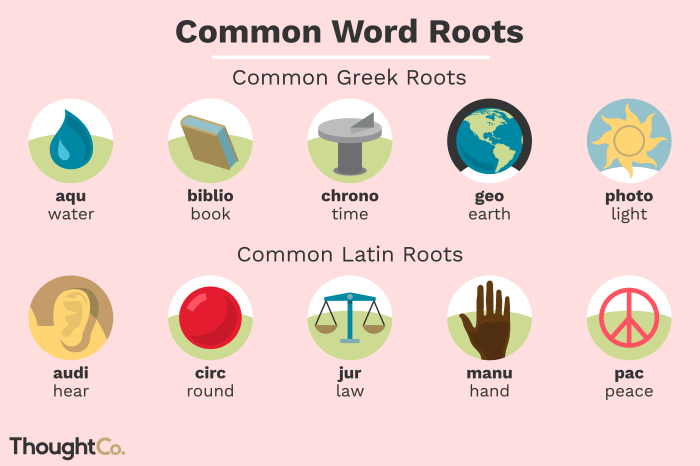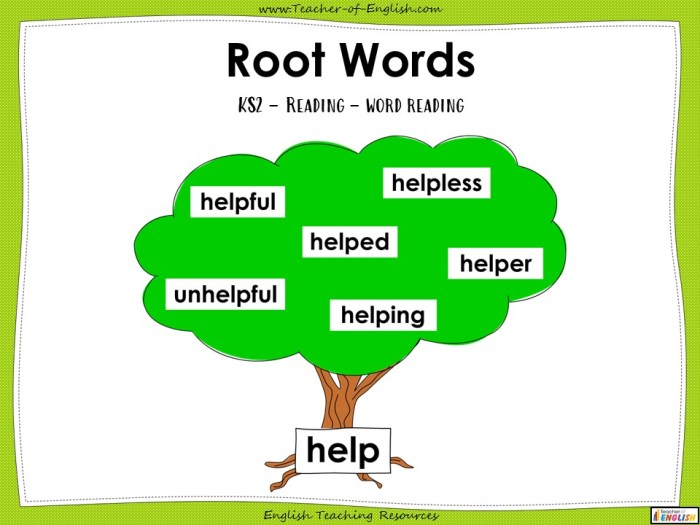Words with the root ceph – Words with the root “ceph” evoke images of heads, intellect, and the vast world of cephalopods. From the medical realm to cultural mythology, this linguistic exploration unravels the rich tapestry of words that share a common etymological thread.
Delving into the etymology of “ceph,” we discover its origins in ancient Greek, where it signified “head.” This root has found its way into numerous languages, shaping words that describe everything from anatomical structures to mental capacities.
Words with the Root “Ceph”
The root “ceph” is a Greek word meaning “head.” It is used in a variety of English words, including:
- Cephalic: relating to the head
- Cephalopod: a type of marine animal with a head and tentacles, such as an octopus or squid
- Encephalitis: inflammation of the brain
- Microcephaly: a condition in which the head is abnormally small
Etymology of “Ceph”

The root “ceph” originates from the Greek word “kephale,” meaning “head.” It has been used in various languages and cultures to denote concepts related to the head, mind, or intellect.
Indo-European Origins
The root “ceph” is believed to have Indo-European origins. In Sanskrit, the word “kapala” means “skull,” while in Latin, “caput” refers to the “head.” These words share a common etymological root with “ceph,” indicating its widespread usage across Indo-European languages.
Use in Greek and Latin
In ancient Greek, “kephale” was used to describe the physical head as well as the metaphorical seat of intelligence and thought. The word “kephalos” was also used to refer to a type of fish with a large head. In Latin, “caput” had a similar dual meaning, encompassing both the physical head and the notion of leadership or authority.
Modern Usage
Today, the root “ceph” continues to be used in various scientific and medical terms related to the head and brain. Examples include “cephalic” (pertaining to the head), “cephalopod” (a type of marine animal with a large head), and “cephalalgia” (headache).
Medical Terminology with “Ceph”
The root “ceph” is commonly used in medical terminology to refer to the head. Various medical terms incorporate this root to describe specific parts or conditions related to the head and brain.
Table of Medical Terms with “Ceph”
The following table provides a list of medical terms that use the root “ceph,” along with their definitions, pronunciations, and the part of the body associated with each term:
| Term | Pronunciation | Definition | Part of Body |
|---|---|---|---|
| Cephalalgia | sef-uh-lal-jee-uh | Headache | Head |
| Cephalic | suh-fal-ik | Pertaining to the head | Head |
| Cephalohematoma | sef-uh-loh-hee-muh-toh-muh | Collection of blood beneath the scalp | Head |
| Cephalometry | sef-uh-lah-meh-tree | Measurement of the head | Head |
| Cephalosporin | sef-uh-loh-spor-in | Antibiotic | N/A |
Cephalopods and “Ceph”

The root “ceph” is closely tied to cephalopods, a diverse group of marine invertebrates. The name “cephalopod” comes from the Greek words “kephale” (head) and “podos” (foot), reflecting their unique anatomical feature of having their tentacles or arms attached to their heads.
Cephalopods are characterized by their bilateral symmetry, a mantle cavity, and a closed circulatory system. They possess a highly developed nervous system and sensory organs, including complex eyes and a sophisticated brain. The most well-known cephalopods include octopuses, squids, cuttlefish, and nautiluses.
Words with the root ceph, like “cephalic” and “encephalon,” often refer to the head. This is fitting, given that the Greek word “kephale” means “head.” Interestingly, the fraternity Pi Kappa Phi at Texas A&M uses a badge with a cephalopod on it, a type of marine animal with a head-like structure.
Cephalopods are known for their intelligence, adaptability, and ability to change their appearance, qualities that are also valued by Pi Kappa Phi. Thus, the cephalopod on their badge serves as a symbol of their fraternity’s values and aspirations.
Tentacles and Arms, Words with the root ceph
Cephalopods have a distinctive feature of having tentacles or arms, which are extensions of their heads. These appendages are used for a variety of purposes, including locomotion, capturing prey, and manipulating objects. The number and arrangement of tentacles or arms vary among different cephalopod species.
Mantle and Shell
Cephalopods have a mantle, a muscular structure that surrounds their internal organs. In some species, the mantle is fused with the head, forming a protective covering. In others, the mantle secretes a shell, which provides additional protection and support. The shell can be internal or external, and its shape and size vary greatly depending on the species.
Cephalic Index and “Ceph”

The cephalic index is a measurement of the shape of the human skull. It is calculated by dividing the maximum width of the skull by the maximum length of the skull and multiplying the result by 100. The resulting number is known as the cephalic index.
The cephalic index is used in anthropology to classify human skulls into three main categories:
- Dolichocephalic: Skulls with a cephalic index of less than 75 are considered dolichocephalic, or long-headed.
- Mesocephalic: Skulls with a cephalic index between 75 and 80 are considered mesocephalic, or medium-headed.
- Brachycephalic: Skulls with a cephalic index of 80 or more are considered brachycephalic, or short-headed.
Racial Classification
In the past, the cephalic index was used to classify human races. However, this practice is now considered to be scientifically invalid. There is no evidence to support the claim that the cephalic index is a reliable indicator of race.
Cultural Significance of “Ceph”

Words with the root “ceph” have found their way into various cultural contexts, particularly in literature, art, and mythology. The word “cephalopod” has been used to describe sea creatures with complex heads and limbs, capturing the imagination of writers and artists alike.
Literature
In literature, the term “cephalopod” has been employed to evoke a sense of wonder and mystery. In Jules Verne’s classic novel “Twenty Thousand Leagues Under the Sea,” the giant squid is portrayed as a formidable and enigmatic creature, captivating readers with its size and intelligence.
Art
In the realm of art, “cephalopod” has served as a source of inspiration for painters and sculptors. The intricate patterns and textures of cephalopods have been translated onto canvas and into sculptures, capturing the beauty and diversity of these marine animals.
Mythology
Mythology is another area where “cephalopod” has made its mark. In Greek mythology, the Kraken is a legendary sea monster with multiple heads and arms, symbolizing the dangers and mysteries lurking in the depths of the ocean.
FAQ Explained: Words With The Root Ceph
What is the meaning of the root “ceph”?
The root “ceph” means “head” in ancient Greek.
What are some examples of words that contain the root “ceph”?
Examples include cephalic (relating to the head), encephalon (brain), and cephalopod (a type of mollusk with a head and tentacles).
How is the root “ceph” used in medical terminology?
It is used in terms such as cephalalgia (headache), cephalometry (measurement of the head), and encephalogram (recording of brain activity).
What is the relationship between cephalopods and the root “ceph”?
Cephalopods are named for their prominent heads, which feature complex sense organs and a well-developed brain.
What is the cephalic index?
The cephalic index is a measure of the shape of the human head, used in anthropology to classify populations.